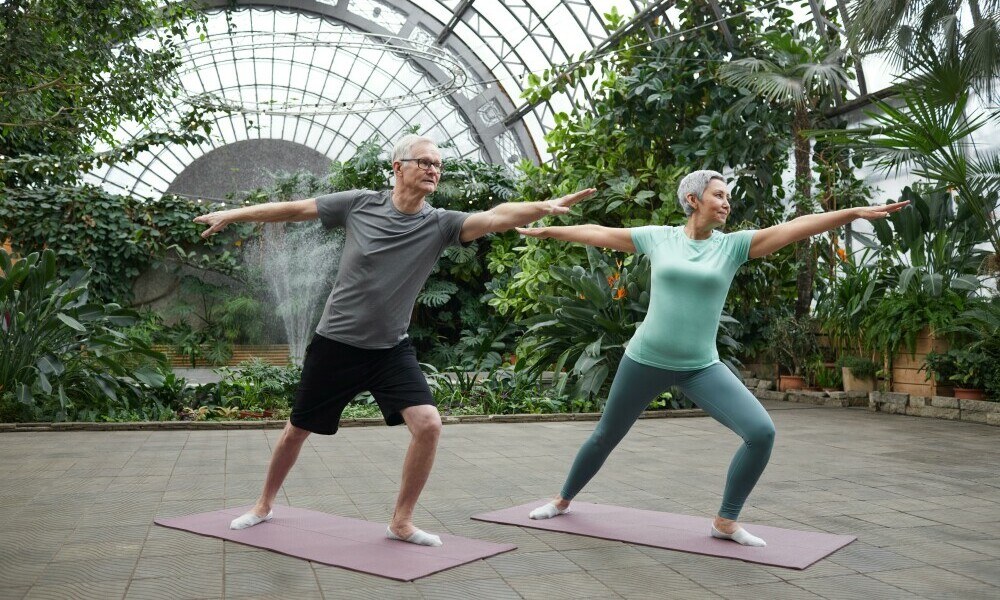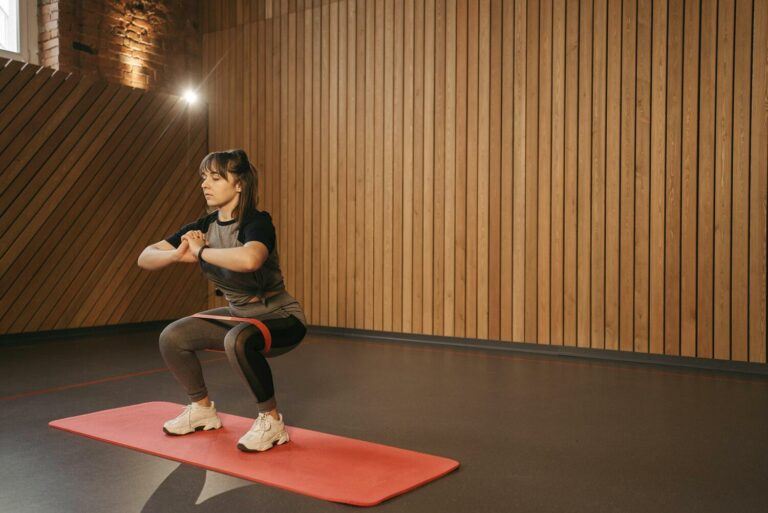Did you know that falls are a leading cause of injury among older adults?
According to the Centers for Disease Control and Prevention (CDC), one in four adults aged 65 and over falls each year [https://www.cdc.gov/falls/index.html].
Maintaining good balance is crucial for preventing falls and staying safe as we age, but it also offers numerous other benefits for people of all ages.

Why Balance Exercises Matter
Balance isn’t just for graceful dancers!
It’s a fundamental skill we use every day, from navigating stairs and carrying groceries to playing sports and simply walking on uneven ground.
Here’s how good balance can benefit you:
- Reduced Fall Risk: As we age, our balance naturally declines. Regular balance exercises strengthen core muscles and improve reaction time, significantly reducing the risk of falls. (Source: Mayo Clinic [https://newsnetwork.mayoclinic.org/discussion/consumer-health-balance-training-easy-fun-and-important/])
- Improved Coordination and Agility: Strong balance translates to better coordination and agility, allowing you to move with greater ease and confidence. Think smoother turns, sharper reflexes, and a lighter step.
- Enhanced Posture and Core Strength: Balance exercises often target core muscles, which are essential for maintaining good posture. By strengthening your core, you’ll stand taller, feel more stable, and experience less back pain.
- Boosted Confidence: Feeling steady on your feet is empowering! Regular balance training can significantly improve your confidence when performing daily tasks or engaging in physical activities.
Your Daily Balance Workout: No Equipment Required!
Ready to improve your balance and reap the many benefits it offers? This daily workout routine can be done anywhere, anytime, and requires no equipment.
It’s designed to be gentle on your joints while effectively challenging your balance.
Important Note: Before starting any new exercise program, it’s always a good idea to consult with your doctor, especially if you have any existing health conditions.
Warm-Up (1-2 minutes):
- Arm Circles: Make 10 small circles forward with each arm, then reverse direction for another 10 circles.
- Torso Twists: Stand with feet shoulder-width apart, hands on shoulders. Gently twist your torso to the right, hold for a second, then repeat on the left side. Do 10 twists on each side.
- Leg Swings: Stand on one leg, holding onto a sturdy support if needed. Swing your other leg forward and backward, keeping it straight. Do 10 swings on each leg.
Balance Exercises (3 sets of 10-12 repetitions each)
Remember to start slow and listen to your body throughout these exercises. If you feel any pain, stop the exercise and consult with a healthcare professional.
Single Leg Stand (Master the Basics):
- Stand tall with feet hip-width apart. Slowly lift one leg off the ground, keeping it straight or slightly bent. Maintain good posture and engage your core muscles. Hold for 10-12 seconds, then switch legs.
- Beginner Tip: Hold onto a wall or chair for additional support.
- Challenge Yourself: Once you’ve mastered the single leg stand with open eyes, try closing your eyes while holding the pose.
Heel-Toe Walk (The Tightrope Challenge):
- Imagine a straight line on the floor. Walk heel-to-toe, placing your heel of one foot directly in front of the toes of the other foot. Focus on maintaining a straight line and good balance. Continue walking for 30 seconds.
Side Leg Lifts (Feeling the Side Hustle):
- Stand tall with feet hip-width apart. Slowly lift one leg out to the side, keeping your hips square and core engaged. Aim to lift your leg as high as comfortably possible. Lower the leg slowly and repeat with the other side. Complete 10-12 repetitions on each leg.
- Modification: Keep the lifted leg slightly bent if a straight leg is challenging.
Marching in Place (High Knees and Beyond):
- March vigorously in place, bringing your knees up high towards your chest. Maintain a tall posture and keep your core engaged. March for 30 seconds.
- Fun Variation: Try “butt kicks” instead of high knees, where you kick your heels towards your glutes.
Tai Chi Sway (Inner Peace, Outer Balance):
- Stand with feet shoulder-width apart, arms extended out to the sides at shoulder height, palms facing down. Slowly shift your weight to one leg, bending that knee slightly. Extend the other leg back and feel a gentle stretch in your calf. Hold for a few seconds, then switch sides. Repeat 5 times on each leg.
- Imagine yourself gently swaying like a willow with the wind, your body finding its center with each shift. Let your breath flow naturally throughout the movement. Engage your core muscles for added stability.
Cool-Down (1-2 minutes):
Taking a few minutes to cool down after your workout helps your body recover and prevents muscle soreness.
- Calf Raises: Stand with feet hip-width apart. Slowly rise onto your toes, hold for a second, then lower back down. Repeat 10-12 times.
- Hamstring Stretch: Sit on the floor with both legs extended in front of you. Reach for your toes, keeping your back straight. Hold for 15-30 seconds.
Balance Issues and Conditions
It’s important to note that while these exercises are generally safe and effective for most people, balance issues can sometimes stem from underlying medical conditions.
If you experience dizziness, vertigo, or any other concerning symptoms while performing these exercises, stop immediately and consult with your doctor.
Inner ear problems or neuropathy can affect balance, and a healthcare professional can help determine the cause and recommend the most appropriate course of action.
Balance Exercises for Seniors
As we age, our balance naturally declines.
This makes it even more important to incorporate regular balance exercises into your routine. However, it’s also crucial to prioritize safety.
Here are a few additional considerations for seniors:
- Start Seated: Begin with exercises that can be performed while seated, such as leg lifts or seated Tai Chi movements. This allows you to build strength and confidence before progressing to standing exercises.
- Sturdy Support is Your Friend: When performing standing exercises, always have a sturdy surface like a wall, chair, or countertop nearby for support. Don’t hesitate to hold on for balance, especially if you feel unsteady.
- Listen to Your Body: Pay close attention to your body’s signals. If you experience any pain or discomfort, stop the exercise and consult with a doctor or physical therapist. They can help you modify exercises or suggest alternative approaches to improve your balance safely.
Unlocking Your Balance Potential
This daily workout is a fantastic starting point for improving your balance. But what if you’re looking for a little more challenge, or want to tailor the exercises to your specific fitness level?
Modification Magic:
- Beginner: Feeling wobbly on single leg stands? Hold onto a wall or chair for support. For heel-toe walks, widen the imaginary line on the floor for extra stability.
- Intermediate: Try closing your eyes while performing single leg stands or heel-toe walks. For side leg lifts, add light ankle weights for an extra challenge.
- Advanced: Want to push your balance further? Try single leg stands on an uneven surface like a pillow or yoga mat. For side leg lifts, lift your leg higher or pulse it up and down a few times at the top of the movement.
Progression Power:

Ready to take your balance training to the next level? Here are some ways to progress your exercises:
- Increase repetitions and sets: As you get stronger, gradually increase the number of repetitions and sets you perform for each exercise.
- Hold poses longer: Challenge yourself to hold single leg stands or Tai Chi sways for longer durations.
- Add single leg exercises: Once you’ve mastered single leg stands, incorporate them into other exercises like squats, lunges, or rows.
- Explore balance tools: Consider using a BOSU ball (half-stability ball) or wobble board to further challenge your balance. Remember to start slowly and prioritize safety when using these tools.
Conclusion
Investing in your balance pays off in countless ways.
By incorporating these simple daily exercises into your routine, you can improve your stability, coordination, and overall well-being.
Remember, consistency is key! Make these exercises a regular part of life, and feel the confidence of finding your inner balance.
Bonus Tip: Looking for additional ways to challenge your balance? Consider taking a yoga or tai chi class, both of which focus heavily on balance and stability.
So lace up your shoes, stand tall, and get ready to find your center!



